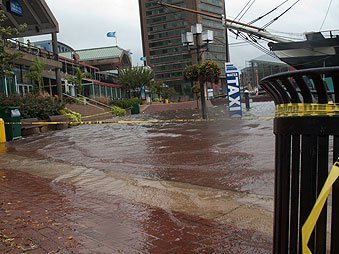INTRODUCING THE DP3 PLANNING PROCESS
What is DP3?
The Disaster Preparedness and Planning Project (DP3) is a new initiative by the Department of Planning that will combine three different planning elements to become one final DP3 plan.
Every five years the Federal Emergency Management Agency (FEMA) requires local governments to update their All Hazards Mitigation Plan (AHMP). In an effort to plan for existing hazards and prepare for predicted hazards due to climate change, the Office of Sustainability will develop and implement an integrated program that combines the AHMP, floodplain mapping, and Climate Adaptation Plan to provide the City with a comprehensive system for addressing existing and future impacts.
This project will ensure that adaptation recommendations are included in future decision making on capital and operating budgets and prioritized within planning processes.
 |
|
What is Hazard Mitigation and why is it important?
|
According to FEMA, hazard mitigation is sustained action taken to reduce or eliminate long-term risk to people and their property from hazards. The purpose of mitigation planning is to identify policies and actions that can be implemented over the long term to reduce risk and future losses.
 Above: Image of Inner Harbor Flooding 2010
In 2000, President Obama signed into law the Disaster Mitigation Act of 2000 (DMA 2000). Part of this act requires local governments to develop and submit a hazard mitigation plan as a condition of receiving mitigation project grants. Hazard mitigation plans are required to be updated every five years.
The City’s AHMP will act as the foundation for Baltimore’s long-term strategy to reduce disaster losses, damage, and expenses. In addition to existing hazards, other climate-related impacts are already affecting Baltimoreans. Heat waves, sea level rise, and flooding due to more extreme precipitation events, will all impact the City’s environmental, social, and economic systems. The City of Baltimore will incorporate adaptation efforts into a plan which recommends changes to better respond to new climate conditions, thereby reducing risk and increasing resiliency.

Integrating hazard mitigation planning which focuses on past events with climate adaptation planning and a focus on what will likely happen in the future is a win-win situation for Baltimore City. Both elements require a detailed inventory of natural hazards, a risk assessment, and a vulnerability analysis. These processes will then inform actions to mitigate hazards and adapt to predicted climate impacts. This process will provide clear guidance and a unified strategy to support Baltimore’s sustainability and resilience.
|
 The Department of Planning assembled a group of experts from around the City and State to help gather essential data and draft recommendations for the DP3. The Advisory Committee consists of city directors from DPW, DOT, DPH, MOEM, Fire, Police and DGS, community leaders, business leaders, climate scientists and representatives from FEMA, MEMA, DNR, local Universities, the port and BGE. The Advisory Committee will meet four times and members will also participate in subcommittees based on their specific areas of expertise.
|
 The recommendations made will be divided into four sectors: infrastructure, buildings, natural systems, and public health & human services. Committee members will consider recommendations such as new building code regulations to offset sea level rise or planting more trees to help manage stormwater runoff and reduce the urban heat island effect. A full list of recommendations will be available by June 1, 2013.
|
For more information, please contact Kristin Baja at Kristin.baja@baltimorecity.gov or (410) 396-5917.

San Francisco Planning Settles Super Bowl Debt in Style
 Prior to Superbowl XLVII, the Planning Departments of Baltimore and San
Francisco made a bet. Since our Ravens beat their 49ers, this video is their payment... a fine rendition of "Good Morning Baltimore"
from the Broadway Musical and movie adaptation of Hairspray. ENJOY and
GO RAVENS!
|
|